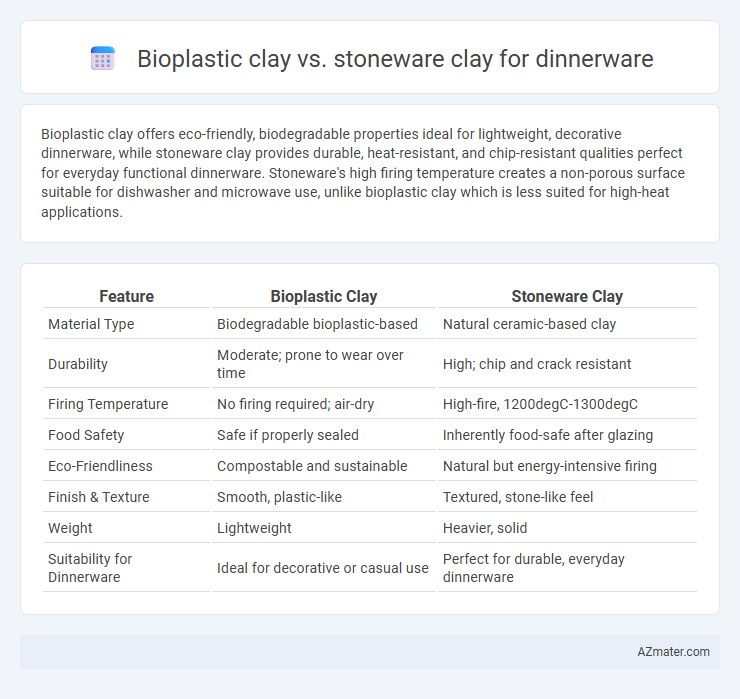Bioplastic clay offers eco-friendly, biodegradable properties ideal for lightweight, decorative dinnerware, while stoneware clay provides durable, heat-resistant, and chip-resistant qualities perfect for everyday functional dinnerware. Stoneware's high firing temperature creates a non-porous surface suitable for dishwasher and microwave use, unlike bioplastic clay which is less suited for high-heat applications.
Table of Comparison
| Feature | Bioplastic Clay | Stoneware Clay |
|---|---|---|
| Material Type | Biodegradable bioplastic-based | Natural ceramic-based clay |
| Durability | Moderate; prone to wear over time | High; chip and crack resistant |
| Firing Temperature | No firing required; air-dry | High-fire, 1200degC-1300degC |
| Food Safety | Safe if properly sealed | Inherently food-safe after glazing |
| Eco-Friendliness | Compostable and sustainable | Natural but energy-intensive firing |
| Finish & Texture | Smooth, plastic-like | Textured, stone-like feel |
| Weight | Lightweight | Heavier, solid |
| Suitability for Dinnerware | Ideal for decorative or casual use | Perfect for durable, everyday dinnerware |
Introduction to Bioplastic Clay and Stoneware Clay
Bioplastic clay is an eco-friendly alternative made from renewable plant-based materials, offering lightweight, flexible, and biodegradable properties ideal for sustainable dinnerware. Stoneware clay, composed of natural minerals like kaolin and feldspar, is fired at high temperatures to create dense, durable, and chip-resistant ceramics commonly used for long-lasting tableware. Comparing their physical characteristics, bioplastic clay excels in environmental impact and versatility, while stoneware clay provides superior strength and heat resistance suitable for everyday use.
Material Composition and Sources
Bioplastic clay is primarily composed of renewable plant-based polymers such as cornstarch or cellulose, making it biodegradable and eco-friendly, whereas stoneware clay consists mainly of natural minerals like kaolin, feldspar, and quartz, sourced from mined earth deposits. Bioplastic clay's organic origins result in a lightweight, flexible material suitable for sustainable dinnerware, while stoneware's mineral-rich composition yields durable, heat-resistant ceramics ideal for everyday use. The environmental impact of bioplastic clay is generally lower due to its renewable sources, whereas stoneware requires extensive mining and high-temperature kiln firing.
Environmental Impact and Sustainability
Bioplastic clay, derived from renewable resources such as starches and biodegradable polymers, offers a lower environmental footprint compared to stoneware clay, which requires extensive mining and high-temperature kiln firing that consumes significant energy. Stoneware clay is durable and long-lasting, yet its production releases more CO2 and depletes natural mineral deposits, whereas bioplastic clay biodegrades efficiently, reducing landfill waste. Sustainable dinnerware choices increasingly favor bioplastic clay due to its renewable sourcing and compostability, aligning with eco-friendly consumer demands.
Durability and Strength Comparison
Stoneware clay demonstrates superior durability and strength compared to bioplastic clay, making it ideal for dinnerware that requires long-lasting use and resistance to chipping. The high firing temperature of stoneware produces a dense, vitrified surface that withstands daily wear and thermal stress better than bioplastic clay, which is more prone to deformation and damage under heat. Stoneware's robust physical properties ensure reliable performance in both microwave and dishwasher environments, whereas bioplastic clay lacks such resilience.
Heat Resistance and Performance in Daily Use
Bioplastic clay offers moderate heat resistance suitable for mild warmth but lacks the durability required for frequent oven or microwave use, making it less ideal for everyday dinnerware subjected to varied temperatures. Stoneware clay boasts high heat resistance, often withstanding temperatures above 1,200degF (650degC), ensuring excellent performance in daily use, including baking, microwaving, and dishwasher-safe durability. The robust thermal properties of stoneware clay make it a preferred choice for reliable, long-lasting dinnerware in regular culinary applications.
Aesthetic Qualities and Design Flexibility
Bioplastic clay offers a highly versatile medium for dinnerware with smooth textures and vibrant color options, allowing for intricate detailing and modern aesthetic appeal. Stoneware clay presents a natural, earthy finish with subtle variegations, providing a rustic and timeless elegance that deepens with glazing techniques. The design flexibility of bioplastic clay excels in lightweight, customizable shapes, while stoneware's durability supports sturdy, traditional forms suited for everyday use.
Food Safety and Non-Toxic Properties
Bioplastic clay offers significant advantages in food safety and non-toxic properties due to its plant-based composition and absence of harmful chemicals, making it an ideal choice for dinnerware that is both eco-friendly and safe for direct food contact. Stoneware clay, while durable and heat-resistant, requires careful glazing to prevent potential leaching of heavy metals or toxins, which can pose food safety concerns if improperly processed. Choosing bioplastic clay ensures a safer, contaminant-free dining experience, aligning with increasing consumer demand for sustainable and health-conscious tableware.
Cost Efficiency and Accessibility
Bioplastic clay offers a cost-efficient alternative for dinnerware production due to its lower raw material costs and ease of handling, making it accessible for small-scale artisans and eco-conscious manufacturers. Stoneware clay, while more durable and heat-resistant, entails higher material and firing expenses, often requiring specialized kilns and longer production cycles. Accessibility favors bioplastic clay in regions with limited ceramic infrastructure, whereas stoneware demands established facilities and expertise, impacting overall cost efficiency in large-scale or commercial settings.
Cleaning, Maintenance, and Longevity
Bioplastic clay offers easier cleaning and lower maintenance due to its non-porous, biodegradable composition, which resists staining and reduces the need for harsh chemicals. Stoneware clay, known for its durability and heat resistance, requires more careful cleaning to avoid chipping but boasts greater longevity under regular use. While bioplastic is eco-friendly and convenient, stoneware remains the preferred material for long-lasting, heavy-duty dinnerware.
Choosing the Right Clay for Sustainable Dinnerware
Bioplastic clay offers eco-friendly benefits with biodegradable properties and lower environmental impact compared to traditional stoneware clay, which requires high firing temperatures and non-renewable resources. Stoneware clay provides durability, heat resistance, and a classic aesthetic ideal for long-lasting dinnerware, while bioplastic clay suits lightweight, disposable, or experimental designs aiming for minimal ecological footprints. Selecting sustainable dinnerware hinges on balancing environmental benefits of bioplastic clay with the functional and timeless qualities of stoneware clay.

Infographic: Bioplastic clay vs Stoneware clay for Dinnerware
 azmater.com
azmater.com